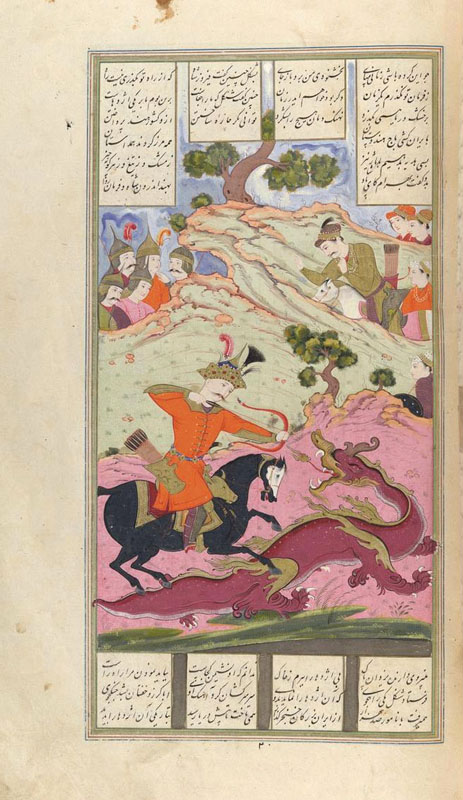Bahrām Gur Kills a Dragon in India
Although the composition is differently arranged, the individual components are similar to the representation of Bahrām Gur’s previous encounter with a dragon represented on folio 347. The action takes place in the extreme foreground. Bahrām Gur, clad identically to his depiction on f. 347, except for the inclusion of a bull-headed mace on his belt, is this time mounted on a black horse that prances over the tail of the dragon. The dragon, virtually a mirror image of the animal shown on f. 347, stretches horizontally across the composition from left to right, but turns its head back toward the center to confront Bahrām, who has bow bent and arrow in place ready for a shot to the dragon’s mouth. The setting is a similar rocky landscape, comprised in two levels of depth, with a ridge just behind the main action, and a second one with a rock outcropping further in the distance. Figures again populate the interstices on either side of the rocky peak: on the left are five warriors with pointed helmets; on the right, however, rather than a horse and groom, are five Indians. The one closest to the foreground is a warrior carrying a shield, and the two furthest in the background might also be of the same vocation. One of the two remaining figures is obviously an attendant, and the other, astride a white horse, his master, who might even be identified as Šangol himself. Two bushes grow at the top of the nearer ridge; a single tree and some sprigs of vegetation emanate from the crest behind. In the far distance is a Moʿin type sky.
Painting: 25.2 x 16.5 cm. The text is written in four columns above and below the painting, with a rectangular frame enclosing painting and text. There is a fine horizontal tear just below the head of the main Indian personage; there are no signs of other damage or retouching. The only signature on the page, raqam-e kamina fażl ʿali, appears in miniscule characters at the extreme top of the painting, next to the trunk of the tree. Attributed by Jackson and Yohannan to Fażl ʿAli, and by Robinson to Moʿin with the assistance of Fażl ʿAli. Although the painting is not signed by Moʿin, it is executed in excellent Moʿin style, and the detailing is indistinguishable from the master’s other work.
For another Moʿin painting of the same subject, see Ms. E, no.10
Painting references:
J&Y_1914, p.38 no.41 (not ill.).
Robinson, Cochran4_1972, p.79, no.41 and p.86, fig.24 .
Cambridge Shahnameh Project
Text references: Warner, VII, pp.124-26; Mohl, VI, p.32.
Robert Eng
Last Updated: February 7, 2011 | Originally published: June 18, 2003
